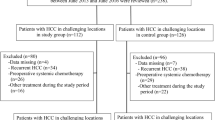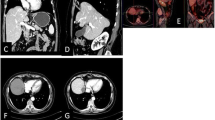Abstract
Purpose
To evaluate the feasibility, efficacy, and safety of microwave ablation (MWA) in the treatment of hepatocellular carcinoma associated with Budd–Chiari syndrome (BCS) after transarterial chemoembolization (TACE).
Methods
A total of 10 patients (mean 50.0 ± 7.5 years) with 15 BCS-associated HCC lesions were retrospectively evaluated. All patients received MWA treatment for residual tumors after 1 to 3 sessions of TACE. The diagnosis of residual tumors was confirmed by at least two types of enhanced imaging. CEUS images were performed to confirm the residual lesions and guide the placement of antenna before MWA. Thermal monitoring and artificial pleural effusion or ascites were used to guarantee ablative accuracy and safety for patients with tumors adjacent to vital structures. Technical success, technique efficacy, local tumor progression, survival rate, and the incidence of complications were comprehensively analyzed.
Results
Technical success and technique effectiveness were achieved in all patients. Thirteen lesions achieved complete ablation for the first time, and 2 lesions needed two sessions. Thermal monitoring was used in 2 patients, artificial pleural effusion was used in 1 patient, and artificial ascites in 2 patients. In a median follow-up of 34.5 months (range 21–52 months), no LTP was founded in all patients. Intrahepatic recurrence was found in 5 patients. 1-, 2-, 3-, and 4-year survival rates were 100%, 100%, 74.1%, and 37.0%, respectively. No major or minor complications were observed.
Conclusion
Microwave ablation is a feasible and effective way to treat residual tumors after TACE treatment in patients with BCS-associated HCC.


Similar content being viewed by others
References
Janssen HL, Garcia-Pagan JC, Elias E, et al. (2003) European Group for the Study of Vascular Disorders of the Liver. Budd–Chiari syndrome: a review by an expert panel. J Hepatol 38:364–371
Goel RM, Johnston EL, Patel KV, Wong T (2015) Budd–Chiari syndrome: investigation, treatment and outcomes. Postgrad Med J91:692–697
MacNicholas R, Olliff S, Elias E, Tripathi D (2012) An update on the diagnosis and management of Budd–Chiari syndrome. Expert Rev Gastroenterol Hepatol 6:731–744
Li SL, Zu MH, Lu ZJ (2012) A review on the research status and trends of Budd–Chiari syndrome. Zhonghua Liu Xing Bing Xue Za Zhi 31:1192–1195
Takayasu K, Muramatsu Y, Moriyama N, et al. (1994) Radiological study of idiopathic Budd–Chiari syndrome complicated by hepatocellular carcinoma. A report of four cases. Am J Gastroenterol 89:249–253
Ren W, Qi X, Yang Z, Han G, Fan D (2013) Prevalence and risk factors of hepatocellular carcinoma in Budd–Chiari syndrome: a systematic review. Eur J Gastroenterol Hepatol 25:830–841
Parikh ND, Fontana RJ (2015) Editorial: hepatocellular carcinoma—a rare complication of hepatic venous outflow tract obstruction. Aliment Pharmacol Ther 41:1212–1213
Plessier A, Sibert A, Consigny Y, et al. (2006) Aiming at minimal invasiveness as a therapeutic strategy for Budd–Chiari syndrome. Hepatology 44:1308–1316
Darwish Murad S, Plessier A, Hernandez-Guerra M, et al. (2009) Etiology, management, and outcome of the Budd–Chiari syndrome. Ann Intern Med 151:167–175
Seijo S, Plessier A, Hoekstra J, et al. (2013) Good long-term outcome of Budd–Chiari syndrome with a step-wise management. Hepatology 57:1962–1968
Copelan A, Remer EM, Sands M, Nghiem H, Kapoor B (2015) Diagnosis and management of Budd Chiari syndrome: an update. Cardiovasc Intervent Radiol 38:1–12
Kirstein MM, Schweitzer N, Ay N, et al. (2016) Experience from a real-life cohort: outcome of patients with hepatocellular carcinoma following transarterial chemoembolization. Scand J Gastroenterol 1–22
Kumar Y, Sharma P, Bhatt N, Hooda K (2016) Transarterial therapies for hepatocellular carcinoma: a comprehensive review with current updates and future directions. Asian Pac J Cancer Prev 17:473–478
Dou JP, Liang P, Yu J (2016) Microwave ablation for liver tumors. Abdom Radiol (NY) 41(4):650–658
Zhang QQ, Zu MH, Xu H, et al. (2013) Combining angioplasty with percutaneous microwave ablation for treating primary Budd–Chiari syndrome associated with hepatocellular carcinoma in two patients: A case report. Oncol Lett 6(2):612–616
European Association For The Study Of The Liver; European Organisation For Research And Treatment Of Cancer (2012) EASL-EORTC clinical practice guidelines: management of hepatocellular carcinoma. J Hepatol 56:908–943
Wang Y, Sun Y, Feng L, et al. (2008) Internally cooled antenna for microwave ablation: results in ex vivo and in vivo porcine livers. Eur J Radiol 67:357–361
Wright AS, Lee FT Jr, Mahvi DM (2003) Hepatic microwave ablation with multiple antennae results in synergistically larger zones of coagulation necrosis. Ann Surg Oncol 10:275–283
Zhang M, Liang P, Cheng ZG, et al. (2014) Efficacy and safety of artificial ascites in assisting percutaneous microwave ablation of hepatic tumours adjacent to the gastrointestinal tract. Int J Hyperthermia 30:134–141
Zhang D, Liang P, Yu X, et al. (2013) The value of artificial pleural effusion for percutaneous microwave ablation of liver tumour in the hepatic dome: a retrospective case–control study. Int J Hyperthermia 29:663–670
Yang W, Yan K, Wu GX, et al. (2015) Radiofrequency ablation of hepatocellular carcinoma in difficult locations: Strategies and long-term outcomes. World J Gastroenterol 21:1554–1566
Ahmed M, Solbiati L, Brace CL, et al. (2014) Image-guided tumor ablation: standardization of terminology and reporting criteria—a 10-year update. Radiology 273:241–260
Livraghi T, Meloni F, Di Stasi M, et al. (2008) Sustained complete response and complications rates after radiofrequency ablation of very early hepatocellular carcinoma in cirrhosis: Is resection still the treatment of choice? Hepatology 47:82–89
Shin SH, Chung YH, Suh DD, et al. (2004) Characteristic clinical features of hepatocellular carcinoma associated with Budd–Chiari syndrome: evidence of different carcinogenic process from hepatitis B virus-associated hepatocellular carcinoma. Eur J Gastroenterol Hepatol 16:319–324
Gwon D 2nd, Ko GY, Yoon HK, et al. (2010) Hepatocellular carcinoma associated with membranous obstruction of the inferior vena cava: incidence, characteristics, and risk factors and clinical efficacy of TACE. Radiology 254:617–626
Liu C, Liang P, Liu F, et al. (2011) MWA combined with TACE as a combined therapy for unresectable large-sized hepotocellular carcinoma. Int J Hyperthermia 27:654–662
Martens P, Nevens F (2015) Budd–Chiari syndrome. United European. Gastroenterol J 3(6):489–500
Ebied OM, Federle MP, Carr BI, et al. (2003) Evaluation of responses to chemoembolization in patients with unresectable hepatocellular carcinoma. Cancer 97:1042–1050
Bruix J, Sala M, Llovet JM (2004) Chemoembolization for hepatocellular carcinoma. Gastroenterology 127:S179–S188
Wang YD, Xue HZ, Zhang X, et al. (2013) Clinical and pathological features and surgical treatment of Budd–Chiari syndrome-associated hepatocellular carcinoma. Chin Med J (Engl) 126:3632–3638
Fong ZV, Tanabe KK (2014) The clinical management of hepatocellular carcinoma in the United States, Europe, and Asia: a comprehensive and evidence-based comparison and review. Cancer 120:2824–2838
Llovet JM, Schwartz M, Mazzaferro V (2005) Resection and liver transplantation for hepatocellular carcinoma. Semin Liver Dis 25:181–200
Poulou LS, Botsa E, Thanou I, Ziakas PD, Thanos L (2015) Percutaneous microwave ablation vs radiofrequencyablation in the treatment of hepatocellular carcinoma. World J Hepatol 7:1054–1063
Park H, Yoon JY, Park KH, et al. (2012) Hepatocellular carcinoma in Budd–Chiari syndrome: a single center experience with long-term followed-up in South Korea. World J Gastroenterol 18:1946–1952
Author information
Authors and Affiliations
Corresponding author
Ethics declarations
Funding
This study was funded by National Key Technology Research and Development Program of China (2013BAI01B01) and National Natural Science Foundation of China (CN) (81430039).
Conflict of interest
Authors declare no conflict of interest.
Ethical approval
All procedures were in accordance with the ethical standards of the institutional and/or national research committee and with the 1964 Helsinki declaration and its later amendments or comparable ethical standards.
Informed consent
Informed consent was obtained from all individual participants included in the study.
Rights and permissions
About this article
Cite this article
Dou, JP., Yu, J., Han, Zy. et al. Microwave ablation for hepatocellular carcinoma associated with Budd–Chiari syndrome after transarterial chemoembolization: an analysis of ten cases. Abdom Radiol 42, 962–968 (2017). https://doi.org/10.1007/s00261-016-0923-4
Published:
Issue Date:
DOI: https://doi.org/10.1007/s00261-016-0923-4




